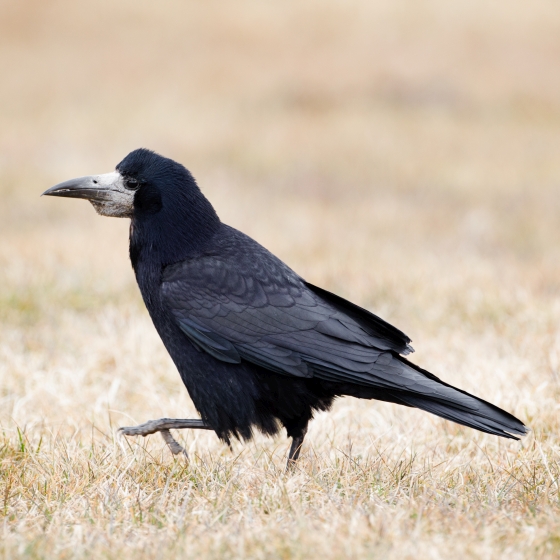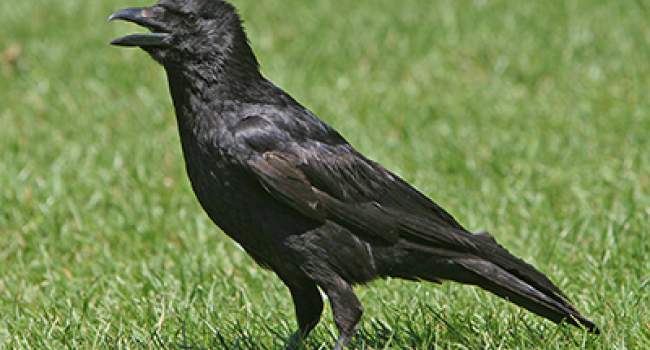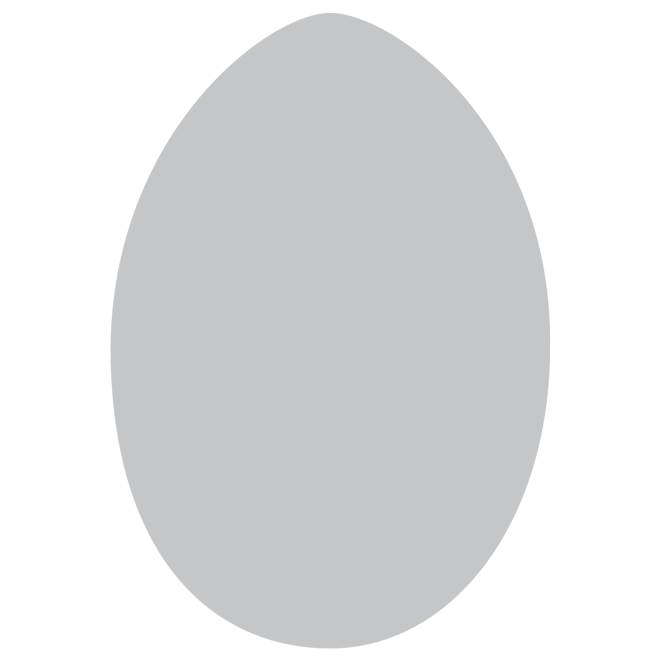Rook
Corvus frugilegus (Linnaeus, 1758)
RO
 ROOK.
ROOK.  15630
15630

Family: Passeriformes > Corvidae

Of the five species of black ‘crows’ found in the UK, the Rook can be told by its cone-shaped head and bare-skinned face.
The Rook is a very sociable bird. It feeds in large, garrulous flocks in its favoured farmland habitat, seeking out a variety of seeds, roots and soil invertebrates. Rooks are colonial nesters, building their nests within a metre or two of their neighbours. Once established, these rookeries can be enduring; some are known to have been in use at the same site for over 100 years.
The Rook is a widespread and common bird, found all across the UK. It is a resident species that has experienced population declines since about the year 2000, particularly in Wales and Scotland.
Exploring the trends for Rook
Our Trends Explorer will also give you the latest insight into how the UK's Rook population is changing.
trends explorerIdentification
Rook identification is sometimes difficult. The following article may help when identifying Rook.
Identifying Corvids - Crow, Chough, Jackdaw, Rook and Raven

A black crow flies over - but is it a Crow, a Rook or even a Raven? Let this video help you to separate these confusing species, along with their smaller cousins: Jackdaw and Chough.
SONGS AND CALLS
Listen to example recordings of the main vocalisations of Rook, provided by xeno-canto contributors.
Call
Develop your bird ID skills with our training courses
Our interactive online courses are a great way to develop your bird identification skills, whether you're new to the hobby or a competent birder looking to hone your abilities.
Browse training coursesStatus and Trends
Population size and trends and patterns of distribution based on BTO surveys and atlases with data collected by BTO volunteers.
CONSERVATION STATUS
This species can be found on the following statutory and conservation listings and schedules.
POPULATION CHANGE
Relatively few rookeries fell within CBC plots, but an index calculated from the available CBC nest counts showed a shallow, long-term increase (Wilson et al. 1998). Increase to the mid 1990s was confirmed by the results of the most recent BTO rookeries survey, which identified a 40% increase in abundance between 1975 and 1996 (Marchant & Gregory 1999). This increase probably reflected the species' considerable adaptability in the face of agricultural change. BBS indices, which are drawn from sightings during transect walks and not from BBS's nest counts, suggest that a notable decrease has occurred subsequently, affecting all countries within the UK, particularly Wales and Scotland. The BBS map of change in relative density between 1994-96 and 2007-09 indicates that there had been increases during that period in Northern Ireland and in lowland regions of England and Wales but decreases in many upland areas and in eastern coastal areas of Scotland. There has been little change in breeding productivity since the 1960s but a decrease in brood size is now becoming evident. There has been an increase across Europe since 1980 (PECBMS: PECBMS 2020a>).
| UK breeding population |
-20% decrease (1995–2020) 
|
Exploring the trends for Rook
Our Trends Explorer will also give you the latest insight into how the UK's Rook population is changing.
trends explorerDISTRIBUTION
Rooks maintain a nearly ubiquitous distribution across much of Britain & Ireland. Though they are absent from larger conurbations, such as London, the lowland distribution of Rooks includes virtually every 10-km square with major gaps confined to higher ground in Scotland, parts of northern England, Wales and the rugged far northwest of Ireland. Rooks favour open, lowland countryside, being less abundant through the wooded Wealden counties of England, for example, than in the arable east of Britain or the eastern and southern counties of Ireland. In general, Rooks are more abundant in Ireland than in Britain.
Occupied 10-km squares in UK
| No. occupied in breeding season | 2319 |
| % occupied in breeding season | 77 |
| No. occupied in winter | 2451 |
| % occupied in winter | 81 |
European Distribution Map
Relative frequency by habitat
Relative occurrence in different habitat types during the breeding season.

DISTRIBUTION CHANGE
There have been only relatively small changes in the distribution of Rooks over the last 40 years. Since the 1968–72 Breeding Atlas some losses have occurred in and around the fringes of the species’ northerly range, in the Scottish Highlands, and also in northwest Ireland.
Change in occupied 10-km squares in the UK
| % change in range in breeding season (1968–72 to 2008–11) | -3.5% |
| % change in range in winter (1981–84 to 2007–11) | +0.2% |
SEASONALITY
Rook is recorded throughout the year on up to 30% of complete lists.

Movement
Information about movement and migration based on online bird portals (e.g. BirdTrack), Ringing schemes and tracking studies.
RINGING RECOVERIES
View a summary of recoveries in the Online Ringing Report.
Foreign locations of birds ringed or recovered in Britain & Ireland

Biology
Lifecycle and body size information about Rook, including statistics on nesting, eggs and lifespan based on BTO ringing and nest recording data.
PRODUCTIVITY & NESTING
Exploring the trends for Rook
Our Trends Explorer will also give you the latest insight into how the UK's Rook population is changing.
trends explorerSURVIVAL & LONGEVITY
View number ringed each year in the Online Ringing Report
Maximum Age from Ringing 
|
22 years 11 months 0 days (set in 2005) 
|
Typical Lifespan 
|
6 years with breeding typically at 2 year |
Adult Survival 
|
0.79  
|
Juvenile Survival 
|
0.25 (in first year) 
|
Exploring the trends for Rook
Our Trends Explorer will also give you the latest insight into how the UK's Rook population is changing.
trends explorerBIOMETRICS
Wing Length 
|
Adults | 311.2±12.9 | Range 290–331mm, N=596 |
| Juveniles | 297.6±12 | Range 280-317mm, N=42 | |
| Males | 321.3±10.7 | Range 306–340mm, N=153 | |
| Females | 303.3±10.3 | Range 290–321mm, N=122 |
Body Weight 
|
Adults | 452±53.26 | Range 370–527g, N=442 |
| Males | 485±43.67 | Range 425–550g, N=113 | |
| Females | 425±44.53 | Range 360–514g, N=90 |
Feather measurements and photos on featherbase 
CODES & CLASSIFICATION
Ring size 
|
E or F (pulli F) |
Field Codes 
|
2-letter: RO | 5-letter code: ROOK. | Euring: 15630 |
For information in another language (where available) click on a linked name
Research
Interpretation and scientific publications about Rook from BTO scientists.
CAUSES AND SOLUTIONS
Causes of change
There is little good evidence available regarding the drivers of the breeding population increase in this species in the UK.
Further information on causes of change
No further information is available.
Information about conservation actions
Although it is believed that numbers increased during the late twentieth century, the drivers of the subsequent decline in the current century are unknown and further research is needed before evidence-based conservation actions can be proposed to reverse the recent declines.
In the meantime and until further research confirms the drivers of the population changes, actions to restore or create species-rich grassland and to provide other foraging habitats may benefit rooks. As a colonial nesting species, it could also be vulnerable to exploitation of rookeries by humans and predators, and therefore actions and policies to protect breeding sites may also be prudent.
Links to more information from ConservationEvidence.com
Would you like to search for another species?












Share this page